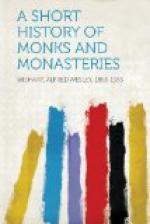Dominic de Guzman, 1170-1221 A.D.
Half-way between Osma and Aranda in Old Castile, Spain, is a little village known as “the fortunate Calahorra.” Here was the castle of the Guzmans, where Dominic was born. His family was of high rank and character, a noble house of warriors, statesmen and saints. If we accept the legends, his greatness was foreshadowed. Before his birth, his mother dreamed she saw her son under the figure of a black-and-white dog, with a torch in his mouth. “A true dream,” says Milman, “for he will scent out heresy and apply the torch to the faggots;” but, as will be seen later, this observation does not rest on undisputed evidence.
[Illustration: PHOTOGRAVURE—RINGLER CO
SAINT DOMINIC
FROM A PHOTOGRAPH OF THE PAINTING PRESERVED IN HIS CELL IN THE CONVENT OF SANTA SABINA, AT ROME
TRENTON: ALBERT BRANDT, PUBLISHER, 1900]
In the year 1191, when Spain was desolated by a terrible famine, Dominic was just finishing his theological studies. He gave away his money and sold his clothes, his furniture and even his precious manuscripts, that he might relieve distress. When his companions expressed astonishment that he should sell his books, Dominic replied: “Would you have me study off these dead skins, when men are dying of hunger?” This noble utterance is cherished by his admirers as the first saying from his lips that has passed to posterity.
Dominic was educated in the schools of Palencia, afterwards a university, where he devoted six years to the arts and four to theology. In 1194, when twenty-five years of age, Dominic became a canon regular, at Osma, under the rule of St. Augustine. Nine years after he accompanied his bishop, Don Diego, on an embassy for the king of Castile. When they crossed the Pyrenees they found themselves in an atmosphere of heresy. The country was filled with preachers of strange doctrines, who had little respect for Dominic, his bishop, or their Roman pontiff. The experiences of this journey inspired in Dominic a desire to aid in the extermination of heresy. He was also deeply impressed by an important and significant observation. Many of these heretical preachers were not ignorant fanatics, but well-trained and cultured men. Entire communities seemed to be possessed by a desire for knowledge and for righteousness. Dominic clearly perceived that only preachers of a high order, capable of advancing reasonable argument, could overthrow the Albigensian heresy.




